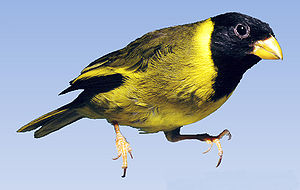Golden Oriole
| Golden Oriole | ||||||||||||
|---|---|---|---|---|---|---|---|---|---|---|---|---|

Golden Oriole ( Linurgus olivaceus ) |
||||||||||||
| Systematics | ||||||||||||
|
||||||||||||
| Scientific name of the genus | ||||||||||||
| Linurgus | ||||||||||||
| Reichenbach , 1850 | ||||||||||||
| Scientific name of the species | ||||||||||||
| Linurgus olivaceus | ||||||||||||
| ( Fraser , 1842) |
The oriole finch ( Linurgus olivaceus ), also known as the oriole finch , is a small species from the goldfinch subfamily . It occurs in four subspecies exclusively in tropical Africa. The IUCN classifies the species as not endangered ( least concern ).
Appearance
The golden oriole reaches a body length of thirteen centimeters. A gender dimorphism is present.
The males of the oriole finches have a black head and a black throat. The wings and tail feathers are also black. The tail feathers have olive-green hems. In the nominate form , the back and the small wing covers are also black. The plumage on the top of the body is otherwise olive green. The underside of the body is greenish yellow. The color varies depending on the subspecies from a more pronounced shade of yellow to a more olive green color. The beak is strikingly separated from the head plumage and is orange in color. The eyes are dark brown.
The black markings are not present in the female. Parts of the body that are black feathered in the male are dark gray-green in the female. Only the wings and tail feathers are blackish. The rest of the plumage is olive green, but the color is darker than that of the male. The beak lacks the strong orange hue. In the female it is more orange-brown.
Way of life and distribution
The golden oriole has a disjoint distribution area in tropical Africa that covers a total of 215,000 square kilometers. It inhabits the island of Bioko , the high plains of Cameroon , the south-east of Nigeria , the east of the Congo , the south-east of Sudan , Kenya , Tanzania and the north of Malawi . Its habitat is high altitude. It occurs mainly at an altitude of 1000 to 3500 meters. Its habitat are slopes with a vegetation of grasses, tall wild herbs, bushes and isolated trees. Mostly he appears in small groups. It is often associated with the brown-eyed bird.
The nest is built low in bushes or small trees and is often no more than a meter above the ground. It is cup-shaped and consists of fine grasses, fibers, lichens and mosses. The clutch comprises two to four eggs. The incubation period is 14 days.
Individual evidence
- ↑ a b BirdLife Factsheet , accessed July 15, 2009
- ↑ a b Bielfeld, p. 72
literature
- Horst Bielfeld : siskins, giraffe, bullfinches and grosbeak. Verlag Eugen Ulmer, Stuttgart 2003, ISBN 3-8001-3675-9 .
Web link
- Linurgus olivaceus inthe IUCN 2013 Red List of Threatened Species . Listed by: BirdLife International, 2012. Retrieved January 3, 2014.